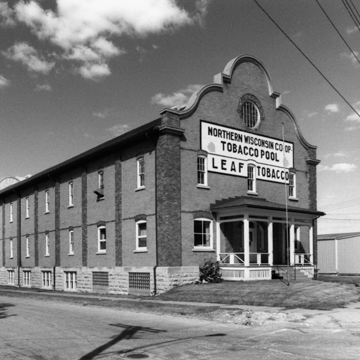Wisconsin tobacco farming first took root in the 1850s in the state’s south-central area. By 1910, a second tobacco-growing region had emerged in the hilly western counties, especially around Viroqua. Norwegians were preeminent in the industry everywhere. In Dane and Rock counties, Yankee tobacco farmers in the mid-nineteenth century often looked to the sizable Norwegian settlements nearby when they needed seasonal workers. Over time, many of the workers built up sufficient capital to own their own tobacco farms and warehouses. When Norwegians moved from south-central Wisconsin to establish new communities farther west, they brought their knowledge of tobacco cultivation with them.
Tobacco buyer Martin Bekkedahl built these two warehouses to heat the dried leaves to remove any remaining moisture and to induce fermentation. In the warehouse basement, women hand-sorted the leaves by length, and others baled them in wooden boxes for shipping. Bekkedahl went bankrupt in the early 1920s when tobacco prices crashed. That crisis prompted area growers to band together as the Northern Wisconsin Cooperative Tobacco Pool, one of the nation’s first large farmers’ cooperatives. The pool bought one of Bekkedahl’s warehouses in 1922 and still owns and uses it. The other belongs to the Viroqua Leaf Tobacco Company. Both are long, two-story brick buildings with quarry-cut stone foundations and one-story hipped entrance porches. They are utilitarian structures, yet their detailing shows an aesthetic sensibility. At the gable ends of the Northern Wisconsin Cooperative Tobacco Pool Warehouse (502 E. Decker), for example, curvilinear parapets embellish the roofline. Red brick walls contrast with brown brick pilasters at the corners, molding around the gable window, and segmental-arched window hoods that are connected by a stringcourse on the first story. The Viroqua Leaf Tobacco Company Warehouse (518 E. Walnut) is plainer, yet its pedimented gable, pressed-metal acroteria, brown brick pilasters, and hipped ventilators suggest a classical influence.


